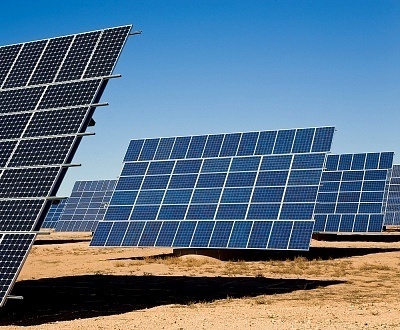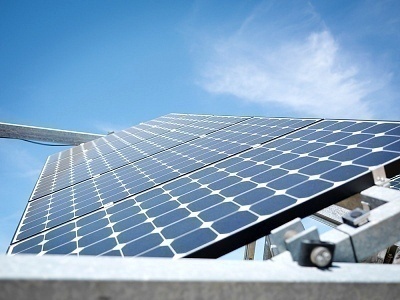How Solar Panels Work
Solar panels are technically any kind of panel that uses solar thermal energy to produce electricity. There are a variety of panel types, from those used to heat water as with solar hot water panels, to those which are used to store solar energy, such as solar thermal energy panels. Furthermore, a solar panel can be described as a photovoltaic panel, which is what is used in the professional solar power industry to generate electricity from the rays of the sun. Despite the type of solar panel being discussed, almost all solar panels are flat. This is due to the fact that the surface needs to be at a 90 degree angle from the suns rays for optimal configuration.
Photovoltaic panels, the most common form of solar panels in the professional electrical generation industry, are able to absorb energy from the sun through a variety of smaller solar cells on their surface. Much like how a plant is able to absorb energy from the sun for photosynthetic purposes, solar cells behave in a similar fashion. As the photons from the sun’s rays hit the solar cells on a photovoltaic panel, the energy is transferred to a silicon semiconductor. The photon is then transformed into electricity and then passed through connecting wires to finally enter a power generation facility or battery.
The solar cells on calculators and satellites are photovoltaic (PV) cells or simply a group of cells electrically connected and parceled in one frame. Photovoltaics, where photo means light and voltaic means electricity, transforms sunlight directly into electricity. ¬Photovoltaic cells are prepared with particular materials called semiconductors such as silicon, which is presently the most generally used. When light hits the ¬Photovoltaic cell, a specific share of it is absorbed inside the semiconductor material. This means that the energy of the absorbed light is given to the semiconductor. The energy unfastens the electrons, permitting them to run freely. ¬Photovoltaic cells also have one or more electric fields that act to compel electrons unfastened by light absorption to flow in a specific direction. This flow of electrons i¬s a current, and by introducing metal links on the top and bottom of the -Photovoltaic cell, the current can be drawn to use it externally.
The Future of Solar Panels
The current generation solar panels are extremely inefficient, and can really only harness as much as thirty percent of a sun ray’s power in the form of usable electricity. This problem is partly due to the materials used in the design of the solar panel as well as the size of solar panel itself. Because of the relatively small range of wavelengths of light that can be harnessed by solar panels, much of the energy which could be gained from the sun’s light is simply left to waste. Furthermore, if a photon of light hits the solar panel at too high of a speed, the energy will not be properly transferred to the solar panel as usable energy.
Modern materials and new techniques for designing solar panels are on the horizon, but promises of increased efficiency have yet to be delivered. The newer silicon crystals that are cheaper to manufacture have the downside that they are not as efficient as the original crystal silicon, but larger panels are cheaper to produce giving a similar or better amount electricity for the same investment.
How to Make Solar Panels
Solar panels are rather complicated yet very simple at the same time.This can be shown below.
Silicon
The reason that solar panels are made of silicon is that silicon atoms hold three separate groups of electrons. One group has two electrons, another has eight electrons, and the third has four electrons. Because the third group only has four electrons, it still has four open spots in which electrons from other atoms can fill. When this happens, the silicon atom and the other atoms become bonded together to form a crystalline lattice. Crystalline lattices are important to solar panels because they allow electrons to break away from the structure later on in the process.
Doping
Doping refers to purposely adding impurities to an element, such as silicon. Doping is a part of the solar panel process because pure silicon is not a very good conductor of electricity. This is because pure silicon forms such a tightly-bound structure that its electrons are no longer able to move freely. By doping the silicon with an impurity such as phosphorous, which has five electrons in its shell instead of four, there are a lot more free carriers.
Free Carriers
A free carrier is an electron that has been knocked loose from its atom and is able to move to a different atom, carrying its electric charge with it. Free carriers are caused by overloads from electric forces, such as heat from light energy. In silicon-phosphorous compounds, the phosphorous atoms provide free carriers as each phosphorous atom has one additional electron that is not connected to the silicon atoms. Because there is an excess of electrons in a silicon-phosphorous compound, the silicon atom has a negative charge. As the other side of a solar panel is doped with boron, an element that’s shell only has three electrons (a lack of electrons when compared to silicon), it has a positive charge. The negative charge then flows to the positive charge, creating an electric current.
Efficiency
The average solar panel used in industrial purposes has an efficiency rate of about 12%. The most ground-breaking research in the world has invented a solar panel that has a 40% efficiency rate. While this is good, it is still not as good as scientists would like. That is because 1,000 watts of electricity from the Sun is constantly shining on every square meter on the Earth’s surface. If scientists could get 100% of that electricity, or close to it, people worldwide would be able to power their homes for free and live much more energy-efficient lifestyles without burning any fossil fuels.
Future Solar Panels
Future solar panels will, hopefully, be much more efficient and supply much of the world’s energy needs. Future solar panels may cover all roofs, building tops, walls, and cars. There may also be large “solar farms” where solar energy is collected, such as the vast numbers of solar panels located at Nellis Air Force Base in Nevada. It is unclear how exactly society will incorporate solar panels into their daily lives but it is clear that solar panels are getting better all the time and they will continue to do so for a long time.


Comments - 5 Responses to “How Solar Panels Work”
Sorry but comments are closed at this time.